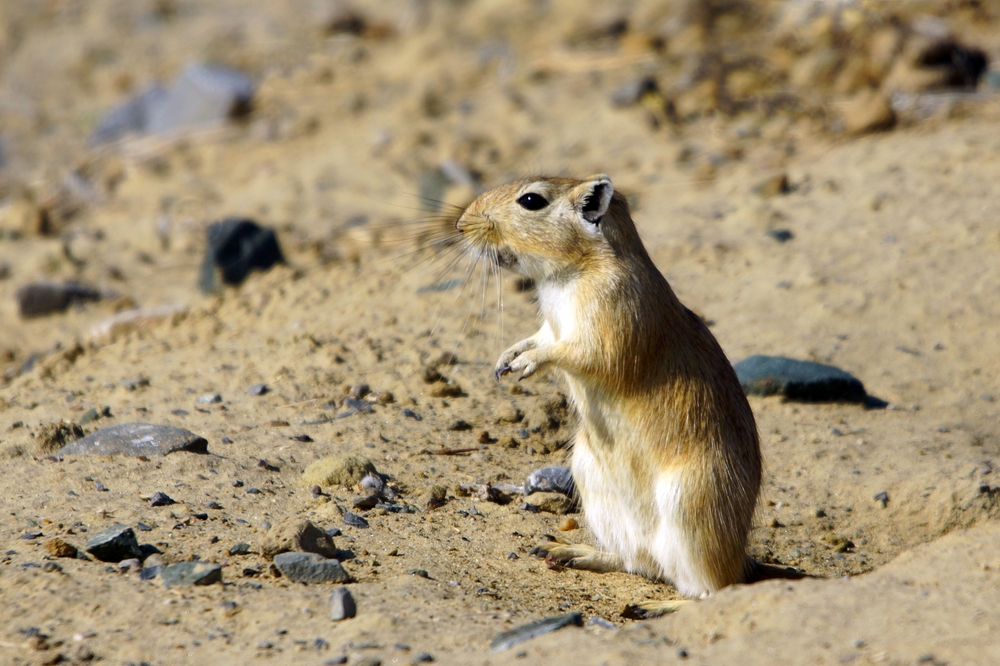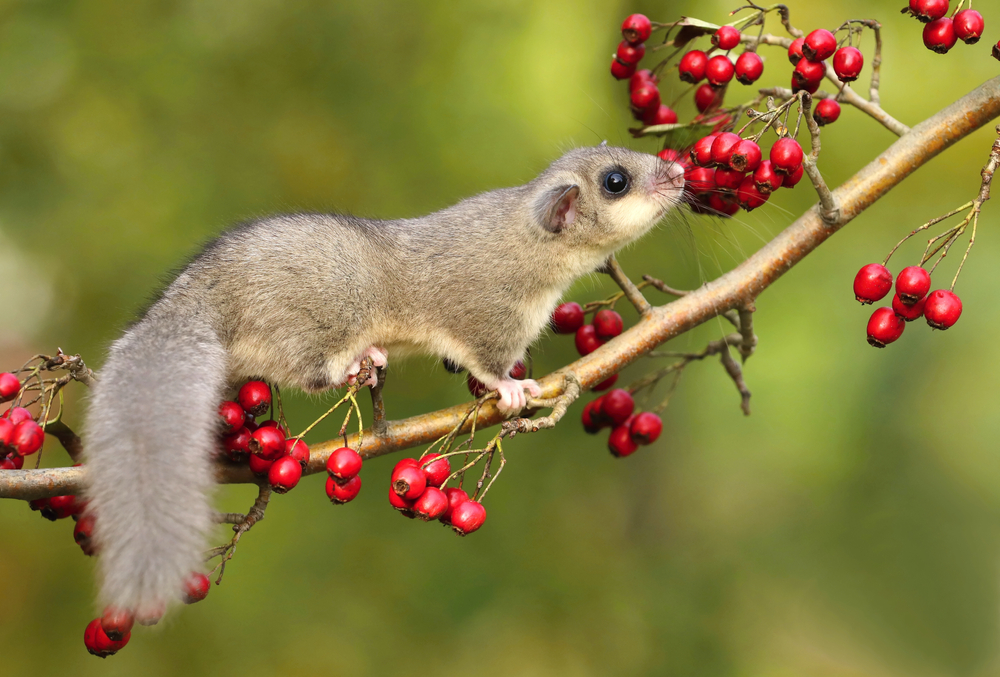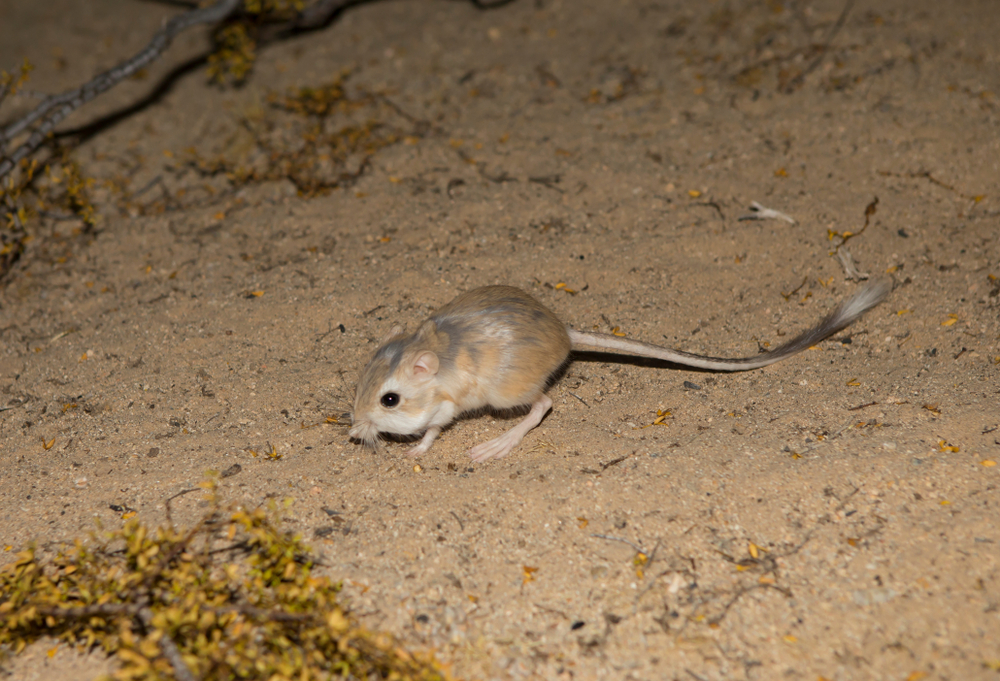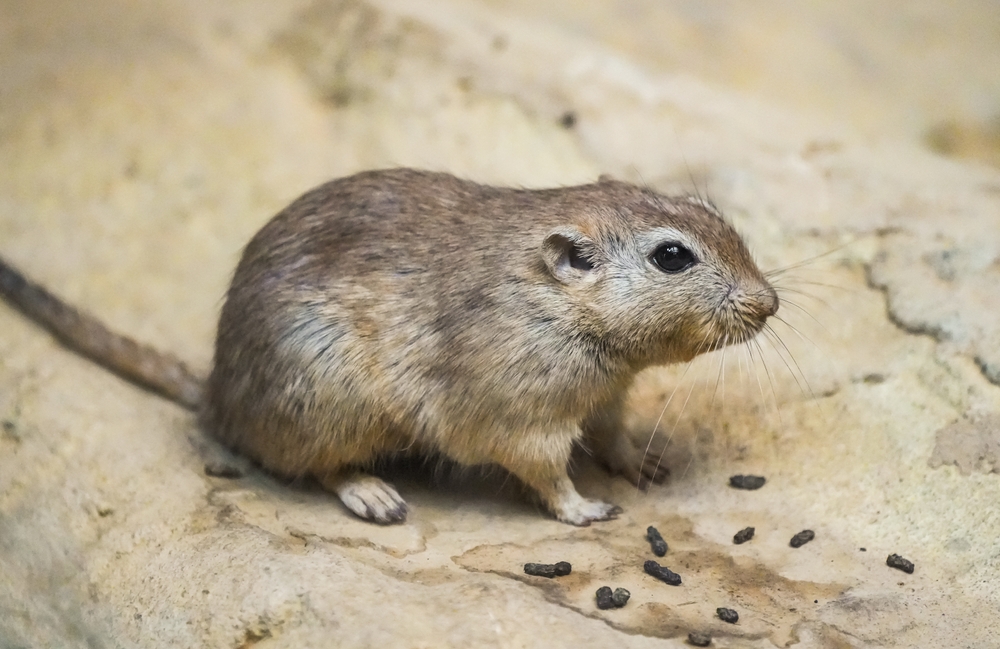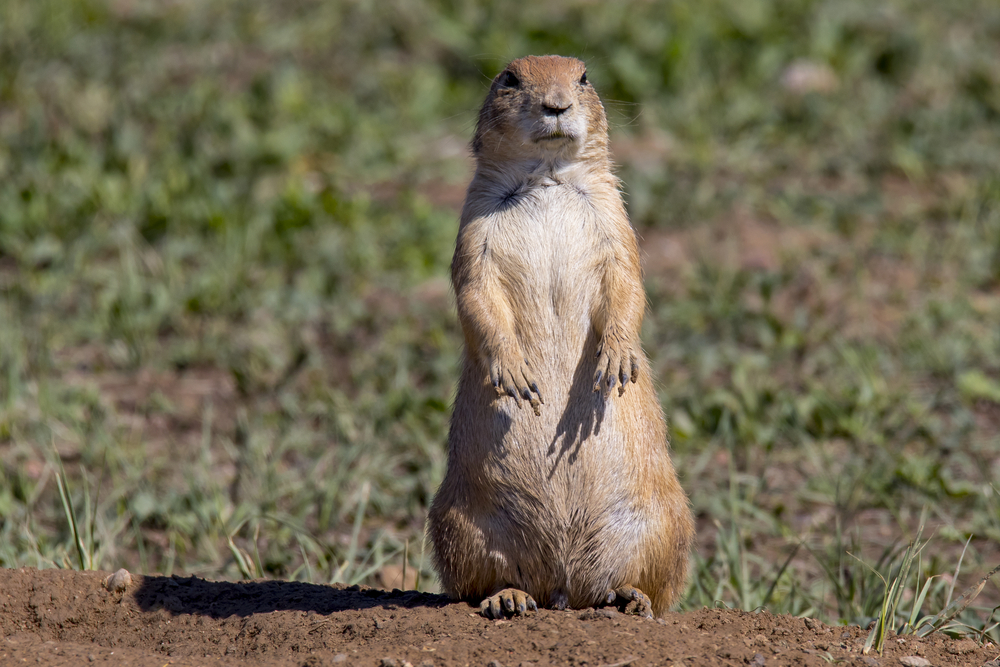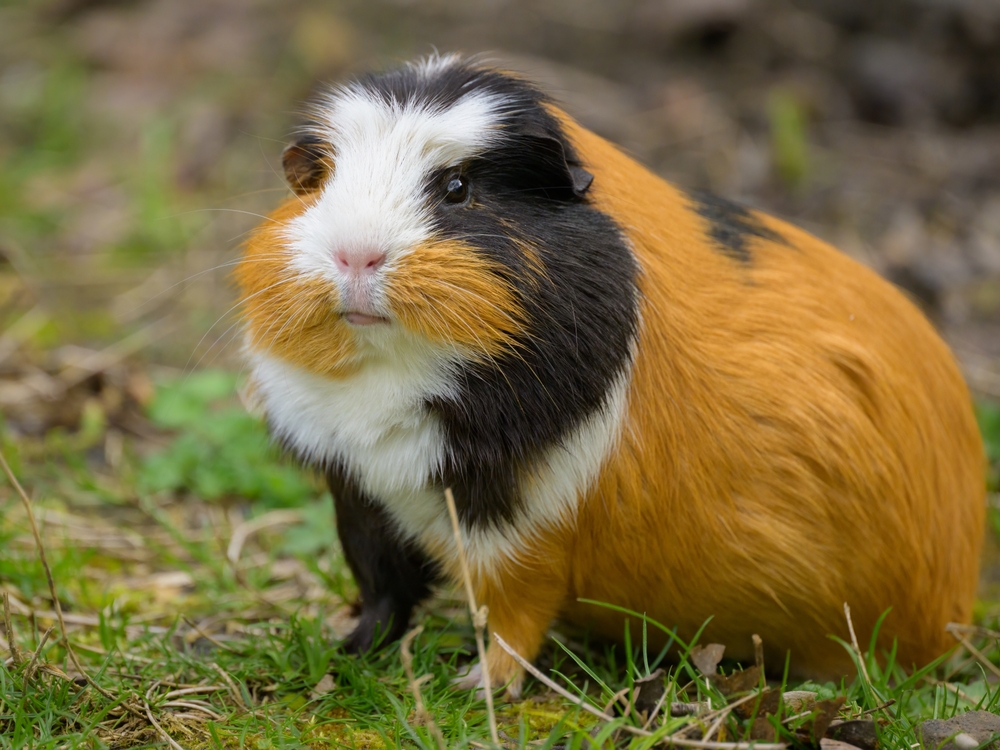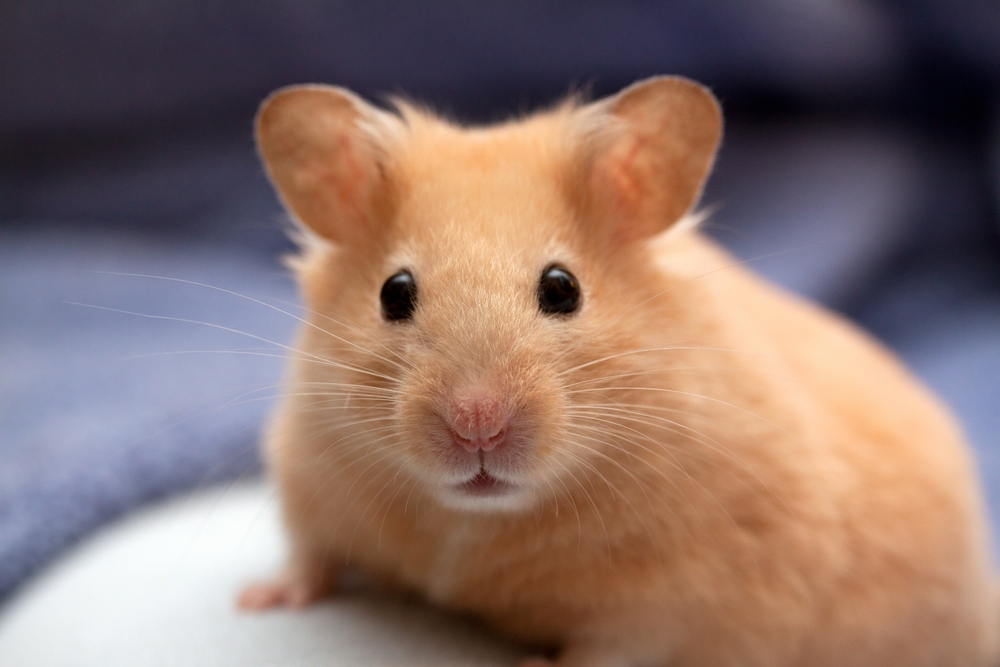The closest relative is the Yellow Ground Squirrel (Spermophilus fulvus), which shares a similar Central Asian range, burrowing lifestyle, and mixed herbivorous diet. However, Yellow Ground Squirrels are not true gerbils, lack cheek pouches, and are larger-bodied with a different tail structure. Among true gerbils, the Tamarisk Jird (Meriones tamariscinus) is its closest counterpart.
About
The Great Gerbil is a large burrowing rodent native to the arid and semi-arid regions of Central Asia, including Kazakhstan, Uzbekistan, Mongolia, China, and parts of Iran and Afghanistan. Belonging to the family Muridae, it is the largest gerbil species and is highly adapted to life in open steppes and deserts.
Adults measure 30–40 cm (12–16 in) in total length, including a long, tufted tail, and weigh 130–300 g (4.5–10.5 oz). Their fur is dense and sandy-brown to gray, blending well with dry soils, while the underparts are paler. They have large eyes and ears, giving them keen senses for detecting predators.
Great Gerbils live in extensive burrow systems that may have dozens of entrances and can house multiple family groups. These burrows provide protection from extreme weather and predators, as well as storage chambers for seeds, roots, and bulbs. Their social structure is cooperative, with groups working together to maintain and defend their colonies.
They are omnivorous, feeding mainly on seeds, roots, and green vegetation, but they will also consume insects when available. Foraging usually occurs near the safety of their burrows, and their activities play a role in seed dispersal and soil aeration.
In some regions, Great Gerbils are considered agricultural pests due to their ability to damage crops. They are also significant in public health, as they can act as a reservoir host for plague-causing bacteria (Yersinia pestis), making their populations an important focus for disease monitoring.
The Great Gerbil’s scientific name is Rhombomys opimus, and it belongs to the family Muridae.
Physical Characteristics
Fur and Coloration:
The Great Gerbil has dense, soft fur that is sandy-brown to grayish-brown on the upper body, blending with dry steppe and desert terrain. The underparts are pale cream to white. The tail is covered in short fur with a darker tuft at the tip.
Head and Eyes:
The head is large and elongated with prominent dark eyes adapted for low-light vision. The ears are moderately large, rounded, and sparsely furred, providing good hearing for predator detection.
Body:
This is a large and powerfully built rodent, much heavier and bulkier than typical gerbils. The body is sturdy with a strong chest, giving it the endurance needed for digging extensive burrow networks.
Legs and Feet:
-
Hind Legs: Strong and moderately long, adapted for both running and digging, but not specialized for bipedal hopping like kangaroo rats.
-
Forelegs: Equipped with strong claws for burrow excavation.
-
Feet are covered with fine hair to provide insulation from hot or cold ground.
Tail:
Relatively long—about 60–80% of body length—used for balance during running and maneuvering. The tail has a darker dorsal stripe and ends in a tuft.
Size:
-
Body Length: 15–20 cm (5.9–7.9 in)
-
Tail Length: 11–14 cm (4.3–5.5 in)
-
Weight: 130–300 g (4.6–10.6 oz)
Sexual Dimorphism:
Minimal; males and females are similar in coloration and body proportions, though males are often slightly larger and heavier.
The Great Gerbil’s large size, sandy camouflage, and powerful digging limbs make it an impressive and highly adapted burrow-dwelling rodent of Central Asia’s deserts and steppes.
Reproduction
Mating Behavior:
Great Gerbils are generally monogamous or live in small family groups within shared burrow systems. Males and females communicate through scent marking and vocalizations. Courtship is brief, often followed by rapid copulation inside or near the burrow entrance.
Breeding Season:
In the wild, breeding typically occurs from spring through late summer (March to August), with peaks in late spring and early summer when vegetation is abundant. In captivity or under favorable conditions, they can breed year-round.
Gestation and Litter Size:
-
Gestation Period: About 23–25 days.
-
Litter Size: Usually 3 to 8 pups, with an average of 5–6.
-
Females can produce up to 3–4 litters per year in good resource years.
Nesting:
Birth takes place in deep, insulated nesting chambers within the burrow system. The nest is lined with dry grasses, plant fibers, and fur for warmth.
Young:
-
Appearance at Birth: Pink, blind, and hairless.
-
Weaning Age: Around 4 weeks.
-
Independence: Juveniles often remain in the parental burrow for several weeks before dispersing to dig their own burrows or join nearby colonies.
Maturity:
Both sexes reach sexual maturity at about 3–4 months of age, enabling rapid population recovery when environmental conditions are favorable.
The Great Gerbil’s short gestation, multiple litters per season, and social burrow system allow it to maintain strong populations even in challenging environments.
Lifespan
Lifespan in the Wild:
In natural desert and steppe environments, Great Gerbils generally live 2 to 4 years. Survival rates are influenced by predation, disease, and fluctuations in food availability.
Lifespan in Captivity:
With stable food supplies, protection from predators, and veterinary care, they can live longer.
-
Average Maximum Lifespan: 5 to 6 years in managed care.
Threats to Longevity:
-
Predation: Vulnerable to raptors, foxes, snakes, and small carnivores.
-
Disease: Populations can be affected by outbreaks of plague (Yersinia pestis), for which they are known natural reservoirs.
-
Harsh Climate: Temperature extremes and seasonal droughts can stress populations.
-
Human Conflict: Considered agricultural pests in some areas, leading to control measures.
Adaptations for Longevity:
-
Extensive Burrow Networks: Provide protection from predators, extreme weather, and disease vectors.
-
Social Structure: Cooperative living in family groups improves survival through shared vigilance and burrow maintenance.
-
Foraging Flexibility: Ability to switch between seeds, roots, and green vegetation depending on seasonal availability.
The Great Gerbil’s burrowing lifestyle, social cooperation, and dietary adaptability help it maintain stable populations across much of Central Asia.
Eating Habits
Diet:
The Great Gerbil is an omnivorous forager, though primarily herbivorous.
-
Primary Foods: Seeds, grains, roots, bulbs, and green vegetation from desert and steppe plants.
-
Seasonal Variation: In spring and summer, they consume more fresh green plants; in autumn and winter, they rely more on stored seeds and roots.
-
Occasional Foods: Insects, especially during periods of high protein demand such as breeding.
Water Acquisition:
-
Obtain most of their water from plant moisture, reducing the need for direct drinking.
-
Efficient kidneys help minimize water loss in arid climates.
Feeding Behavior:
-
Forage both near and far from their burrow systems, often along well-worn paths.
-
Use cheek pouches to carry seeds and plant material back to underground storage chambers.
-
Store large quantities of food in burrows to sustain them during harsh winters and drought periods.
Foraging Strategy:
-
Exploit a wide range of plant species to adapt to seasonal changes in vegetation.
-
May dig for underground plant parts when surface vegetation is scarce.
-
Feed mainly during cooler parts of the day—morning and evening—to avoid midday heat.
Adaptations for Feeding:
-
Strong forelimbs and claws for digging up roots and bulbs.
-
Social burrowing allows multiple individuals to contribute to food gathering and storage.
-
Can switch between grazing on green plants and seed hoarding depending on environmental conditions.
The Great Gerbil’s flexible diet, food caching behavior, and efficien
Uniqueness
Largest Gerbil Species:
The Great Gerbil is the largest living member of the gerbil family, reaching up to 300 g—several times the size of common pet gerbils.
Extensive Burrow Systems:
They create massive, multi-entrance burrow networks that can extend over 100 m², often shared by multiple family groups. These burrows are so extensive they can be seen in satellite imagery.
Social Colony Structure:
Unlike many solitary rodents, Great Gerbils live in cooperative family groups, sharing foraging duties, burrow maintenance, and predator vigilance.
Plague Reservoir Species:
They are known natural reservoirs for the plague bacterium (Yersinia pestis), making them ecologically and epidemiologically significant in Central Asia.
Food Storage Specialists:
Use large underground chambers to store seeds, roots, and bulbs for winter survival, sometimes amassing food stores weighing several kilograms.
Habitat Engineers:
By aerating soil and influencing plant distribution, they play a role as ecosystem engineers in steppe and desert environments.
The Great Gerbil’s large size, complex burrows, and social lifestyle make it one of the most distinctive and ecologically influential rodents in its range.
Be the First to Share Photos of This Species.
FAQ’s
1. What is the closest species to the Great Gerbil?
2. How does the Great Gerbil compare to other rodents?
The great gerbil varies in a number of ways:
-
Size: Significantly larger than most gerbils and many other desert rodents.
-
Social Structure: Highly social, living in cooperative burrow colonies, unlike solitary desert rodents such as kangaroo rats.
-
Burrow Complexity: Creates extensive, multi-entrance tunnel systems visible from the air.
-
Disease Ecology: Unique among many rodents as a known long-term host for plague bacteria.
-
Foraging Behavior: Stores large caches of seeds and roots, similar to hamsters, but on a much larger scale.
3. What national parks provide the best chances to see a Great Gerbil?
Great Gerbils are native to the steppes and deserts of Central Asia. Best viewing opportunities include:
-
Altyn-Emel National Park (Kazakhstan)
-
Ili River Delta Reserves (Kazakhstan)
-
Charyn Canyon National Park (Kazakhstan)
-
Kopet Dag Nature Reserve (Turkmenistan)
-
Barsa-Kelmes Nature Reserve (Kazakhstan)
They are most active in the early morning and late afternoon near burrow entrances.



































































